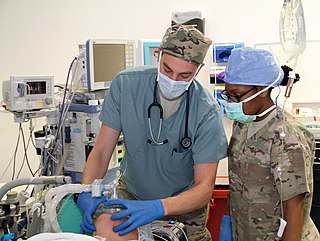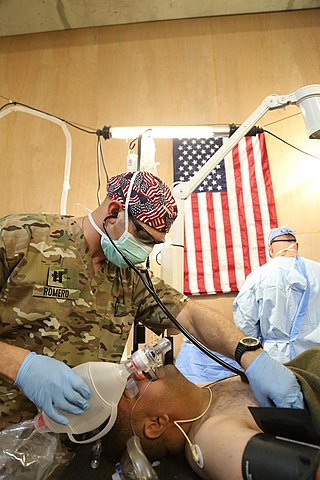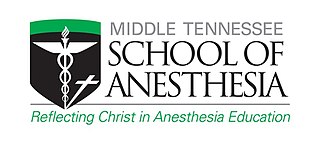Related Research Articles

Anesthesiology, anaesthesiology or anaesthesia is the medical specialty concerned with the total perioperative care of patients before, during and after surgery. It encompasses anesthesia, intensive care medicine, critical emergency medicine, and pain medicine. A physician specialized in anesthesiology is called an anesthesiologist, anaesthesiologist, or anaesthetist, depending on the country. In some countries, the terms are synonymous, while in other countries, they refer to different positions and anesthetist is only used for non-physicians, such as nurse anesthetists.
Awareness under anesthesia, also referred to as intraoperative awareness or accidental awareness during general anesthesia (AAGA), is a rare complication of general anesthesia where patients regain varying levels of consciousness during their surgical procedures. While anesthesia awareness is possible without resulting in any long-term memory of the experience, it is also possible for victims to have awareness with explicit recall, where they can remember the events related to their surgery.

A nurse anesthetist is an advanced practice nurse who administers anesthesia for surgery or other medical procedures. They are involved in the administration of anesthesia in a majority of countries, with varying levels of autonomy. Nurse anesthetists provide all services of anesthesia for patients before, during, and after surgery. Certified Registered Nurse Anesthetists, (CRNA) are dedicated to the safe administration of anesthesia delivery and work within a diverse team. They are dedicated to patient advocacy, safety and professional development. In some localities, nurse anesthetists provide anesthesia to patients independently; in others they do so under the supervision of physicians. In the United States, the physician may be an anesthesiologist, surgeon, or podiatrist. The International Federation of Nurse Anesthetists was established in 1989 as a forum for developing standards of education, practice, and a code of ethics.

A Certified Registered Nurse Anesthetist (CRNA) is a type of advanced practice nurse who administers anesthesia in the United States. CRNAs account for approximately half of the anesthesia providers in the United States and are the main providers (80%) of anesthesia in rural America. Historically, nurses have been providing anesthesia care to patients for over 160 years, dating back to the American Civil War (1861–1865). The CRNA credential was formally established in 1956. CRNA schools issue a Doctorate of nursing anesthesia degree to nurses who have completed a program in anesthesia, which is 3 years in length.
An advanced practice nurse (APN) is a nurse with post-graduate education and training in nursing. Nurses practicing at this level may work in either a specialist or generalist capacity. APNs are prepared with advanced didactic and clinical education, knowledge, skills, and scope of practice in nursing.
The American Society of Anesthesiologists (ASA) is a professional association of physicians in the field of anesthesiology.
In the United States, anesthesia can be administered by physician anesthesiologists, an anesthesiologist assistant, or nurse anesthetist.
Dental anesthesiology is the specialty of dentistry that deals with the advanced use of general anesthesia, sedation and pain management to facilitate dental procedures.
Cardiothoracic anesthesiology is a subspeciality of the medical practice of anesthesiology, devoted to the preoperative, intraoperative, and postoperative care of adult and pediatric patients undergoing cardiothoracic surgery and related invasive procedures.
Geriatric anesthesia is the branch of medicine that studies anesthesia approach in elderly.

Alice Magaw was an American nurse known for her work on anesthesia. Her innovations helped lead to major advances in modern surgery and earned her the title of the 'mother of anesthesia.'
Neurosurgical anesthesiology, neuroanesthesiology, or neurological anesthesiology is a subspecialty of anesthesiology devoted to the total perioperative care of patients before, during, and after neurological surgeries, including surgeries of the central (CNS) and peripheral nervous systems (PNS). The field has undergone extensive development since the 1960s correlating with the ability to measure intracranial pressure (ICP), cerebral blood flow (CBF), and cerebral metabolic rate (CMR).

The American Society of Anesthesia Technologists & Technicians, or ASATT, based in Oak Creek, Wisconsin, is a nonprofit, educational organization responsible for the standards of technologist/technician competency in all areas of anesthesia.
Certified anesthesiologist assistants (CAAs) are master’s degree level non-physician anesthesia care providers. CAAs are members of the anesthesia care team as described by the American Society of Anesthesiologists (ASA). This designation must be disambiguated from the Certified Clinical Anesthesia Assistant (CCAA) designation conferred by the Canadian Society of Respiratory Therapists. All CAAs possess a baccalaureate degree, and complete an intensive didactic and clinical program at a postgraduate level. CAAs are trained in the delivery and maintenance of most types of anesthesia care as well as advanced patient monitoring techniques. The goal of CAA education is to guide the transformation of student applicants into competent clinicians.
The following outline is provided as an overview of and topical guide to anesthesia:

The American Osteopathic Board of Anesthesiology (AOBA) is an organization that provides board certification to qualified Doctors of Osteopathic Medicine (D.O.) and non-osteopathic physicians who specialize in the administration of anesthetic agents and perioperative medicine (anesthesiologists). The board is one of 16 medical specialty certifying boards of the American Osteopathic Association Bureau of Osteopathic Specialists approved by the American Osteopathic Association (AOA), and was established in 1956.

Middle Tennessee School of Anesthesia (MTSA) is a private graduate school specializing in nurse anesthesia education and located in Madison, Tennessee. The schools is accredited by the Council on Accreditation of Nurse Anesthesia Educational Programs of the American Association of Nurse Anesthetists and the Southern Association of Colleges and Schools Commission on Colleges. Founded in 1950 as Madison Hospital School of Anesthesia, it later became Middle Tennessee School of Anesthesia. MTSA offers a Master of Science (MS) with a focus in Nurse Anesthesia as well as Doctor of Nursing Anesthesia Practice (DNAP) degree. It is the second-largest nurse anesthesia program in the United States. The primary clinical affiliate of MTSA is Vanderbilt University.
John Adriani was an American anesthesiologist and director of anesthesiology at Charity Hospital in New Orleans. He was president of the American Board of Anesthesiology (ABA) and he received a Distinguished Service Award from the American Society of Anesthesiologists (ASA). He was an early supporter of physician involvement in nurse anesthetist training.

Frank Moya was an American anesthesiologist, businessman, and educator. He was widely recognized for his research in obstetric anesthesia and newborn physiology, and joined the University of Miami School of Medicine's Department of Anesthesiology as the youngest department chairman in the country, at the age of 33. Moya also held several prestigious national and state Anesthesiology positions and founded the Frank Moya Continuing Education Programs.
Goldie D. Brangman-Dumpson was an American nurse and educator. Brangman-Dumpson was a co-founder of the school of anesthesia at Harlem Hospital, where she worked most of her career. Later, she was the director of the Harlem Hospital School of Nursing. While working at Harlem Hospital, she was part of the surgical team that worked on Martin Luther King Jr. after an attempted assassination on September 20, 1958. Brangman-Dumpson was a lifelong volunteer for the Red Cross and the first African-American president of the American Association of Nurse Anesthetists (AANA).
References
- ↑ "About Certified Registered Nurse Anesthetists". Anesthesia Facts. American Association of Nurse Anesthesiology. Retrieved 4 February 2024.
Founded in 1931, the American Association of Nurse Anesthetists (AANA) is the professional organization representing approximately 90 percent of the nation's CRNAs. AANA members number nearly 59,000, including CRNAs and student registered nurse anesthetists.
- 1 2 3 4 5 "History of AANA". American Association of Nurse Anesthesiology. Retrieved 4 February 2024.
- ↑ "KANA Historical Timeline". Kansas Association of Nurse Anesthetists. Retrieved 6 February 2024.
- ↑ Koch, Kathy (June 2008). "AANA's first annual meeting: the first-fruit of an adventure". AANA Journal. 76 (3): 173–6. PMID 18567319.
- ↑ Elisha, Sass; Nagelhout, John (2017). Nurse Anesthesia. Elsevier Health Sciences. p. 6. ISBN 978-0-323-44437-8 . Retrieved 4 February 2024.
- 1 2 "History of Accreditation". Council on Accreditation of Nurse Anesthesia Educational Programs. 3 January 2020. Retrieved 4 February 2024.
- ↑ AANA press release
- ↑ ASA press release
- ↑ "American Society of Anesthesiologists Condemns the American Association of Nurse Anesthetists' Misleading Name Change". www.asahq.org. Retrieved 4 January 2024.
- ↑ "How calling CRNAs "nurse anesthesiologists" misleads patients". American Medical Association. 27 July 2020. Retrieved 2024-01-04.
- 1 2 "AANA Journal". American Association of Nurse Anesthesiology. Retrieved 4 February 2024.
- ↑ "Profiles of Nurse Anesthetists/Nurse Anesthesiologists". American Association of Nurse Anesthesiology. Retrieved 2024-02-04.